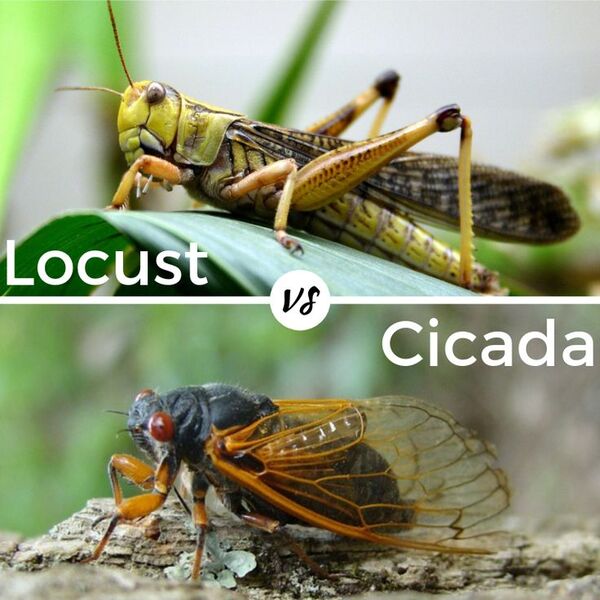Locusts and cicadas are two insects that often cause confusion due to their similar appearance and behaviors. However, locusts and cicadas are fundamentally different species, each belonging to distinct insect families. In this article, we will explore the differences between locusts and cicadas, covering their scientific classifications, behaviors, life cycles, and the environmental impact they have on ecosystems.
Understanding the scientific classification is one of the easiest ways to distinguish locusts from cicadas. Although both insects are often seen as noisy and abundant, they belong to entirely different taxonomic groups.
Family: Acrididae
Order: Orthoptera
Locusts are a type of grasshopper that belong to the family Acrididae within the Orthoptera order. Unlike regular grasshoppers, locusts have the ability to form large swarms that can devastate crops and vegetation.
Family: Cicadidae
Order: Hemiptera
Cicadas belong to the Cicadidae family within the Hemiptera order, which is a completely different order from the locusts. Cicadas are more closely related to other bugs like aphids, shield bugs, and leafhoppers.

While locusts and cicadas may share similar habitats and sometimes cause confusion, they have distinct physical characteristics that make them easy to tell apart.
Locusts are usually medium to large-sized insects, often ranging from 2 to 5 cm long. They have long hind legs, which are adapted for jumping great distances. Their bodies are typically cylindrical and they possess short antennae.
Cicadas are known for their large, broad bodies, which can reach lengths of up to 5 cm or more. They have prominent, membranous wings, with a characteristic wide gap between the eyes. The cicada’s long antennae are also noticeably longer than those of locusts. Cicadas have a more stout, rounded appearance compared to the slimmer, elongated body of locusts.
The behavioral patterns and life cycles of locusts and cicadas are vastly different, further highlighting their distinct nature.
One of the most striking features of locusts is their ability to form massive swarms, especially in times of environmental stress, such as droughts or low food availability. When locusts aggregate into swarms, they can travel across vast distances and consume large amounts of crops, which can have devastating effects on agriculture. The swarming behavior is triggered by changes in temperature, humidity, and food scarcity.
Cicadas are primarily known for their loud, droning songs produced by males to attract mates. Unlike locusts, cicadas do not swarm in large groups. Instead, they have a fascinating lifecycle that involves spending the majority of their lives underground as nymphs. Some species, such as the periodical cicadas, live underground for up to 17 years before emerging as adults to mate, lay eggs, and die shortly after.
Despite their differences, both locusts and cicadas play significant roles in the ecosystems they inhabit.
Locusts are well-known for their destructive capacity as pests. Their swarming behavior can lead to the decimation of crops and cause economic hardship for farmers. In some parts of the world, locust plagues have been known to cause widespread famine and food shortages. As a result, locusts are considered a major agricultural pest.
Cicadas, on the other hand, have a more positive impact on ecosystems. Although they can cause damage to trees during the egg-laying process, cicadas also serve as a food source for many predators, including birds, mammals, and other insects. Additionally, the decomposition of dead cicadas provides essential nutrients to the soil, benefiting plant life in the long term.
| Aspect | Locusts | Cicadas |
|---|---|---|
| Scientific Classification | Family: Acrididae, Order: Orthoptera | Family: Cicadidae, Order: Hemiptera |
| Physical Appearance | Slim, long body with short antennae; large hind legs for jumping | Broad body with large, membranous wings; long antennae |
| Behavior | Form swarms that travel long distances; devastating to crops | Do not swarm; males produce loud songs to attract mates |
| Life Cycle | Egg → Nymph → Adult (with swarming behavior) | Nymphs live underground for many years before emerging as adults |
| Ecological Impact | Major agricultural pest; can devastate crops | Serve as food for predators; enrich soil with nutrients |
| Sound Production | No significant sound production | Males produce loud, droning songs during mating season |
Although locusts and cicadas may seem similar at first glance, they are distinctly different insects with separate taxonomic classifications, behaviors, and ecological impacts. Locusts are grasshoppers that can form swarms and wreak havoc on crops, while cicadas are well-known for their life cycle and loud, seasonal songs. Understanding these differences is essential for anyone interested in the biology and environmental significance of these two fascinating insects.
By recognizing the unique characteristics and behaviors of locusts and cicadas, we can better appreciate their roles in nature and the ways they interact with the ecosystems they inhabit.
animal tags: Cicadidae Acrididae
We created this article in conjunction with AI technology, then made sure it was fact-checked and edited by a Animals Top editor.